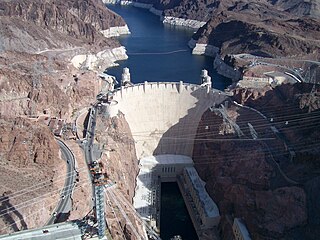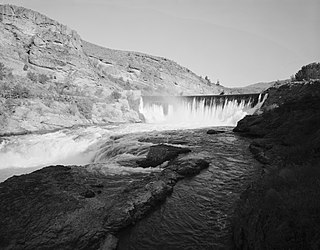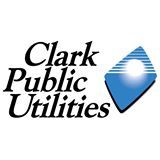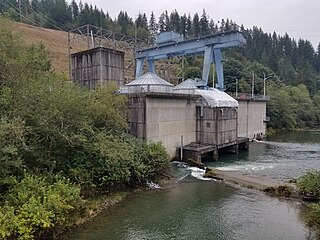Related Research Articles

Grant County is a county located in the U.S. state of Washington. As of the 2020 census, the population was 99,123. The county seat is Ephrata, and the largest city is Moses Lake. The county was formed out of Douglas County in February 1909 and is named for U.S. President Ulysses S. Grant.

The Lower Colorado River Authority (LCRA) is a nonprofit public utility created in November 1934 by the Texas Legislature. LCRA's mission is to enhance the lives of the Texans it serves through water stewardship, energy and community service. LCRA provides public power, manages the lower Colorado River, builds and operates transmission lines, owns public parks, and offers community services.

Ephrata is a city in and the county seat of Grant County, Washington, United States. Its population was 8,477 at the 2020 census.

Rocky Reach Dam is a run-of-the-river hydroelectric dam in the U.S. state of Washington owned and operated by Chelan County Public Utility District. It has 11 generators rated in total 1300 MW. The project is on the Columbia River in north central Washington state about seven miles (11 km) upstream from the city of Wenatchee. The dam is 473 miles (761 km) above the mouth of the Columbia. The reservoir impounded by the dam is Lake Entiat. The project provides energy for more than 7 million people throughout the Pacific Northwest.

Wanapum Dam is a run-of-the-river hydroelectric project located on the Columbia River downstream (south) from Vantage, Washington where Interstate 90 crosses the Columbia from Grant County into Kittitas County. It is owned by the Grant County Public Utility District. Its reservoir is named Lake Wanapum.

Priest Rapids Dam is a hydroelectric, concrete gravity dam; located on the Columbia River, between the Yakima Firing Range and the Hanford Nuclear Reservation, and bridges Yakima County and Grant County, in the U.S. state of Washington. The dam is 24 miles south of the town of Vantage, and 47 miles northwest of the city of Richland. It is located at mile marker 397.1 from the mouth of the Columbia. It is owned by the Grant County Public Utility District (PUD). Priest Rapids, for which the dam was named, are now submerged beneath the dam's reservoir.

Portland General Electric (PGE) is a Fortune 1000, investor-owned energy company based in Portland, Oregon, that generates, transmits and distributes electricity, serving almost two-thirds of Oregon’s commercial and industrial activity. PGE is regulated by the Oregon Public Utility Commission. Founded in 1888 as the Willamette Falls Electric Company, the company has been an independent company for most of its existence, though was briefly owned by the Houston-based Enron Corporation from 1997 until 2006, almost 20 years ago, when Enron divested itself of PGE during its bankruptcy.
Puget Sound Energy, Inc. (PSE) is an energy utility company based in the U.S. state of Washington that provides electrical power and natural gas to the Puget Sound region. The utility serves electricity to more than 1.2 million customers in Island, King, Kitsap, Kittitas, Pierce, Skagit, Thurston, and Whatcom counties, and provides natural gas to 877,000 customers in King, Kittitas, Lewis, Pierce, Snohomish and Thurston counties. The company's electric and natural gas service area spans 6,000 square miles (16,000 km2).
The Chelan County Public Utility District, or Chelan County PUD, provides electric, water, wastewater public utility and telecommunications services in Chelan County, in north-central Washington in the United States.
Seattle City Light is the public utility providing electricity to Seattle, Washington, in the United States, and parts of its metropolitan area, including all of Shoreline, nearly all of Lake Forest Park, and parts of unincorporated King County, Burien, Normandy Park, SeaTac, Renton, and Tukwila. Seattle City Light is the 10th largest public utility in the United States and the first municipal utility in the US to own and operate a hydroelectric facility. In 2005, it became the first electric utility in the United States to fully offset all its carbon emissions and has remained carbon neutral every year since.
Energy Northwest is a public power joint operating agency in the northwest United States, formed 67 years ago in 1957 by Washington state law to produce at-cost power for Northwest utilities. Headquartered in the Tri-Cities at Richland, Washington, the WPPSS became commonly known as "Whoops!", due to over-commitment to nuclear power in the 1970s which brought about financial collapse and the second largest municipal bond default in U.S. history. WPPSS was renamed Energy Northwest in November 1998, and agency membership includes 28 public power utilities, including 23 of the state's 29 public utility districts.
The Douglas County Public Utility District, or Douglas County PUD, is a public co-operative energy district providing service to Douglas County, Washington. It is owned by its customers and governed by a Board of Commissioners elected by the customer-owners. Though it is not regulated by another governmental unit, a PUD is, by state statute, a nonprofit corporation. PUDs must comply with state regulations for municipal corporations. The local customer-owner of the PUD receives dividends in the form of reduced rates for service.
The Quincy-Columbia Basin Irrigation District is a non-profit quasi-municipality located in North Central Washington state that operates and maintains a portion of the Columbia Basin Irrigation Project. The primary function of the Irrigation District is to deliver irrigation water to farm land located in the Columbia River Basin.

The Snohomish County Public Utility District is a public utility agency providing power to over 367,000 customers in Snohomish County and on Camano Island, Washington. It provides water service to about 23,000 customers in the northeast section of the Snohomish County.

Hydroelectricity is, as of 2019, the second-largest renewable source of energy in both generation and nominal capacity in the United States. In 2021, hydroelectric power produced 31.5% of the total renewable electricity, and 6.3% of the total U.S. electricity.

The Enloe Dam, also known as the Similkameen Dam, and its powerplant are located on the Similkameen River about 4 miles (6.4 km) west-northwest of Oroville, Washington. Located just above Similkameen (Coyote) Falls, the concrete arch-gravity dam stands about 54 feet (16 m) high, with a crest length of about 290 feet (88 m), built between 1916 and 1923. The dam was named after the president of the Okanogan Valley Power Company, Eugene Enloe. The dam was operated to generate power at its powerplant, located about 850 feet (260 m) downstream from the dam. Lacking fish ladders, Enloe Dam blocks fish passage and completely extirpated anadromous fish migration into the upper reaches of the Similkameen River and its tributaries in Canada.

Public Utility District No. 1 of Clark County, doing business as Clark Public Utilities and commonly referred to as Clark PUD, is a public utility district in Clark County, Washington. Clark PUD provides electric service to all of Clark County except for the Georgia-Pacific Camas Paper Mill in the City of Camas, and its water service area covers the majority of the county, except the Cities of Battle Ground, Camas, Ridgefield, Washougal, and Vancouver, which have their own municipal water systems.

Electricity in the Puget Sound region is a significant factor in people's lives, an enabler for the modern economy, and has a unique relationship with the region's environment.

The following outline is provided as an overview of and topical guide to infrastructure of the U.S. state of Washington.

The Henry M. Jackson Hydroelectric Project, or Jackson Hydro Project, is an electric power generating project on the Sultan River operated and maintained by the Snohomish County Public Utility District in Washington, co-licensed by the city of Everett, Washington. Beginning operations in 1984, the project aims to bring clean and renewable hydropower to Snohomish county. The facility consists of a single powerhouse, two main generating units, a switch-yard, and transmission lines—all of which are directly connected to the county's local 115 kV power-transmission network. The largest generating station operated by the Snohomish county PUD, the Jackson Hydro powerhouse has a total nameplate capacity of 112 megawatts, enough to power 53,200 homes, and accounts for 7 percent of the Snohomish county PUD's total power needs. The vast remainder of the Snohomish county PUD's power comes from the Chief Joseph Dam, located in eastern Washington, through long-term contracts with the Bonneville Power Administration.
References
- 1 2 http://www.grantpud.org/index.php/your-pud/what-is-a-pud/grant-pud-milestones#30 Grant County PUD History: 1930's
- 1 2 http://www.grantpud.org/index.php/your-pud/what-is-a-pud/grant-pud-milestones#40 Grant County PUD History: 1940's